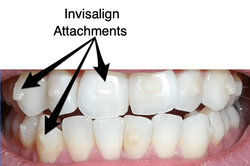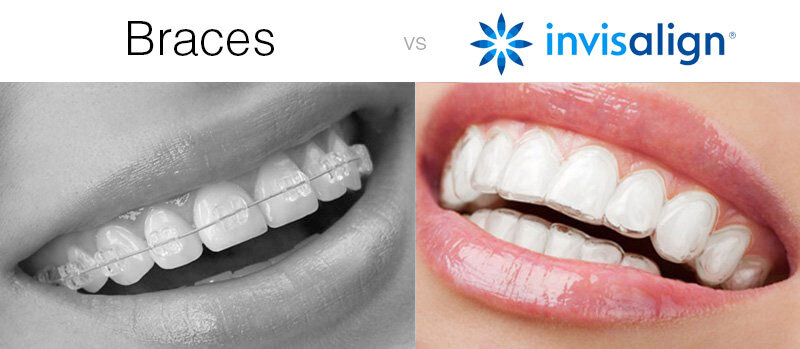Frequently Asked Questions About Invisalign: Everything You Need to Know
Frequently Asked Questions About Invisalign: Everything You Need to Know
Blog Article
Invisalign vs. Conventional Dental braces: Which Choice Is Right for You?
When thinking about orthodontic therapy, the option in between Invisalign and standard dental braces offers several vital elements that warrant cautious assessment. Invisalign supplies a discreet choice with removable aligners, while typical braces give a more noticeable yet reliable service for extreme misalignment. Each alternative encompasses unique advantages and drawbacks related to aesthetics, convenience, therapy duration, and cost. Comprehending these subtleties is vital for making an informed decision that lines up with your personal preferences and way of living. The inquiry remains: which choice will ideal satisfy your orthodontic needs and assumptions?
Summary of Treatment Options

In contrast, standard dental braces consist of metal braces and cords that are bonded to the teeth. This technique uses continuous pressure with time to achieve alignment. While efficient for intricate orthodontic issues, conventional braces require routine visits for adjustments and can position obstacles in keeping dental health as a result of the problem of cleansing about braces and cords.
Both alternatives have their advantages, and the selection usually pivots on specific oral problems, lifestyle preferences, and patient compliance. Ultimately, speaking with an orthodontic professional is essential for establishing one of the most suitable therapy plan customized to private requirements. Understanding the nuances of each alternative can significantly influence the general success of orthodontic therapy.
Aesthetic Factors To Consider
A significant aspect influencing the choice in between Invisalign and standard braces is the aesthetic charm each treatment supplies. Invisalign aligners are crafted from clear plastic, making them basically undetectable when used. This discreet appearance is specifically attracting teens and adults that might feel self-conscious concerning their orthodontic treatment. The capacity to keep an all-natural smile throughout the alignment procedure can substantially enhance the person's self-confidence in professional and social setups.
On the other hand, traditional dental braces contain metal braces and cords, which can be a lot more noticeable. While improvements in orthodontic modern technology have brought about the development of smaller braces and tinted elastics, standard dental braces still preserve a more obvious profile. For some individuals, the presence of braces may prevent them from looking for necessary treatment.
Inevitably, the choice between Invisalign and standard dental braces might pivot on individual preferences relating to aesthetic appeals. People that focus on discernment frequently lean towards Invisalign, while those that are much less concerned regarding exposure might go with traditional braces. Understanding the aesthetic ramifications of each choice is critical for making an educated choice that straightens with one's way of living and choices.
Convenience and Convenience

In terms of convenience, Invisalign aligners are removable, enabling people to appreciate their favored foods without constraint and keep optimum dental hygiene. Cleaning and flossing are streamlined, as the aligners can be gotten during these routines, whereas typical dental braces need mindful navigating around braces and cables.
In comparison, standard braces require regular changes, making them less hassle-free for those with hectic schedules. Generally, the comfort and comfort of Invisalign make it an appealing selection for numerous people seeking orthodontic therapy.
Treatment Period and Effectiveness
While both Invisalign and standard dental braces work in correcting oral imbalances, the duration of therapy can differ considerably between the 2 alternatives. Usually, Invisalign therapy can check it out take anywhere from 12 to 18 months, depending on the intricacy of the instance. The clear aligners work by progressively shifting teeth into their preferred placements, and regular follow-ups with an orthodontist help make certain progress stays on course.
In contrast, conventional dental braces usually require a longer dedication, generally varying from 18 months to 3 years. This is due to their fixed nature and making use of wires and brackets, which can be much more efficient for extreme imbalances and complex cases (Invisalign). The treatment efficiency of typical dental braces is well-documented, as they permit precise adjustments and greater control over tooth movement
Inevitably, the selection between Invisalign and traditional dental braces might depend upon both the awaited therapy duration and the particular dental problems at hand. Consulting with an orthodontist is essential, as they can offer tailored recommendations based upon specific demands, making certain the picked technique lines up with desired durations and results.
Cost Contrast and Insurance Policy Choices
Cost plays a significant duty in the decision-making procedure for individuals considering orthodontic therapy, whether choosing Invisalign or conventional dental braces. Typically, the cost of Invisalign arrays from $3,000 to $8,000, while typical braces generally set you back between $2,000 and $6,000. Elements affecting these costs consist of the intricacy of the situation, the period of therapy, and geographical area.
Insurance coverage can substantially influence out-of-pocket expenditures. Numerous dental insurance strategies give partial insurance coverage for orthodontic treatments, but the specifics can vary extensively. It is important for clients to assess their insurance coverage to identify the level of coverage for either alternative. Typically, typical braces might be more often covered by insurance policy plans contrasted to Invisalign, which some insurance companies classify as a cosmetic procedure.
Furthermore, a number of orthodontic techniques use adaptable payment plans, making both treatment options next page much more easily accessible. People need to ask about potential financing options and discounts for upfront settlements. Evaluating the complete expense, consisting of insurance advantages and settlement strategies, is crucial for making an informed decision that aligns with both visual choices and budget plan considerations.

Conclusion
In recap, the choice in between Invisalign and conventional dental braces hinges on numerous aspects, including visual preferences, comfort, therapy duration, and price. Invisalign offers a very discreet, removable choice that facilitates oral health and dietary versatility, while traditional braces might be better for complex dental concerns and frequently come with a reduced price factor. Inevitably, assessment with an orthodontist is crucial to evaluate private conditions and determine the most ideal treatment option for accomplishing optimum oral alignment.
When considering orthodontic treatment, the selection in between Invisalign and traditional braces presents a number of crucial variables that warrant mindful evaluation.Comparing Invisalign and standard braces reveals distinct treatment choices for orthodontic correction.While both Invisalign and traditional braces are effective in correcting oral imbalances, the period of therapy can vary substantially in between the two choices.Expense plays a considerable function in the decision-making process for individuals thinking about orthodontic treatment, whether opting for Invisalign or traditional dental braces.In recap, the option between Invisalign and typical braces pivots on several elements, including visual choices, comfort, treatment duration, and price.
Report this page